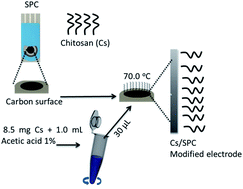A new and simple electroanalytical method to detect thiomersal in vaccines on a screen-printed electrode modified with chitosan
Abstract
The use of a screen-printed electrode modified with chitosan (Cs) to determine thiomersal (TMS) through the oxidation of thiosalicylic acid by linear sweep anodic stripping voltammetry is reported for the first time in this work. The screen-printed electrode was coated with chitosan (Cs/SPCE) and the surface was studied with cyclic voltammetry and electrochemical impedance spectroscopy. The modified electrode presented activity towards the oxidation of thiomersal (TMS) at 0.24 V. The signal is the product of the oxidation of the thiosalicylic acid or organic part and not of the mercury in the chemical structure of thiomersal. Optimal parameters for linear sweep anodic stripping voltammetry were pH 3.2 in phosphate buffer solution (PBS), accumulation time (tACC) 90 s, accumulation potential (EACC) −1.0 V and scan rate 100.0 mV s−1; the oxidation signal was proportional to the concentration of TMS between 0.99 and 10.90 μmol L−1, with a detection limit of 0.038 μmol L−1 and the relative standard deviation (RSD) was 5.0% using seven different electrodes. The sensor was used in human urine samples spiked with thiomersal and commercial cattle vaccines with consistent results.



 Please wait while we load your content...
Please wait while we load your content...